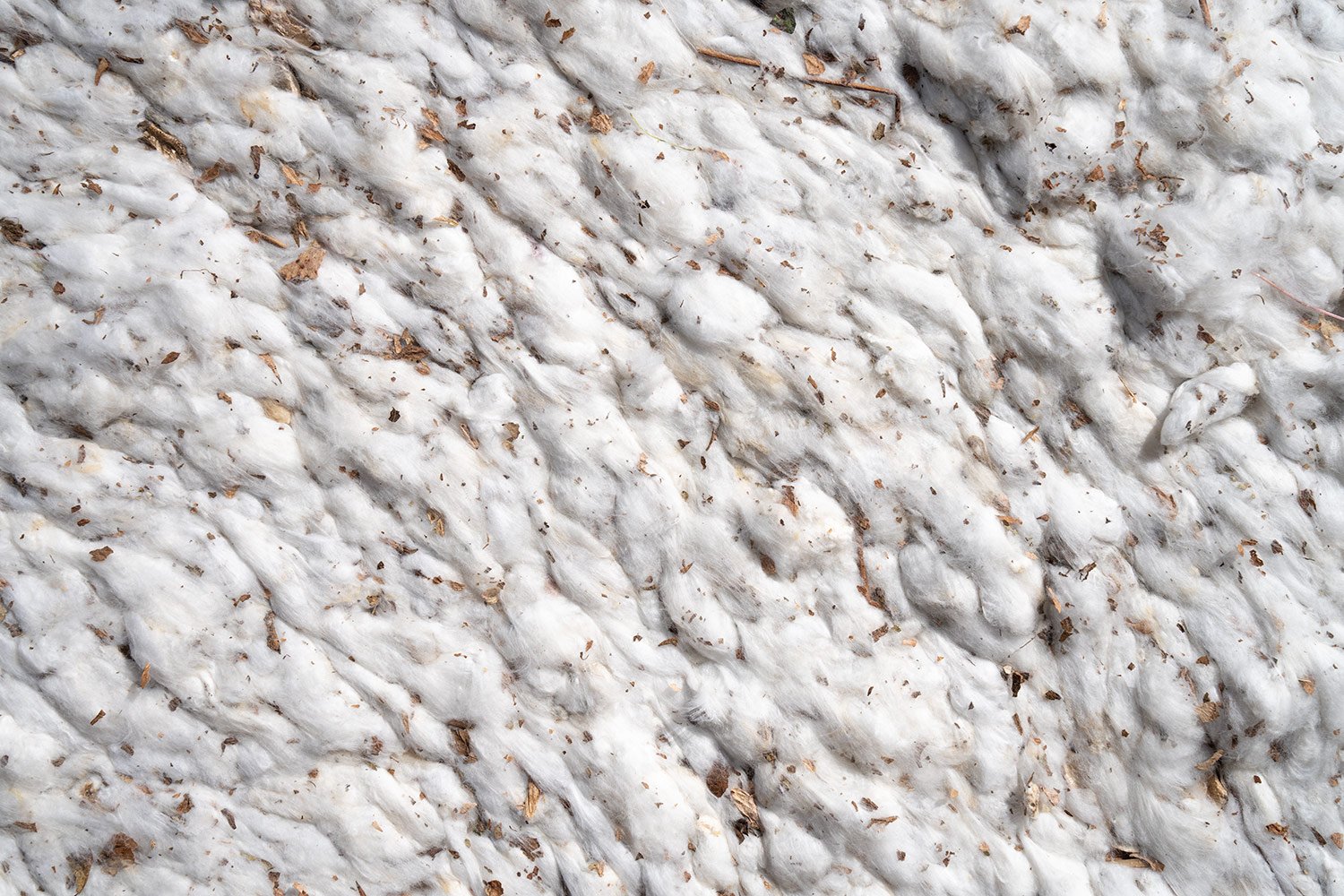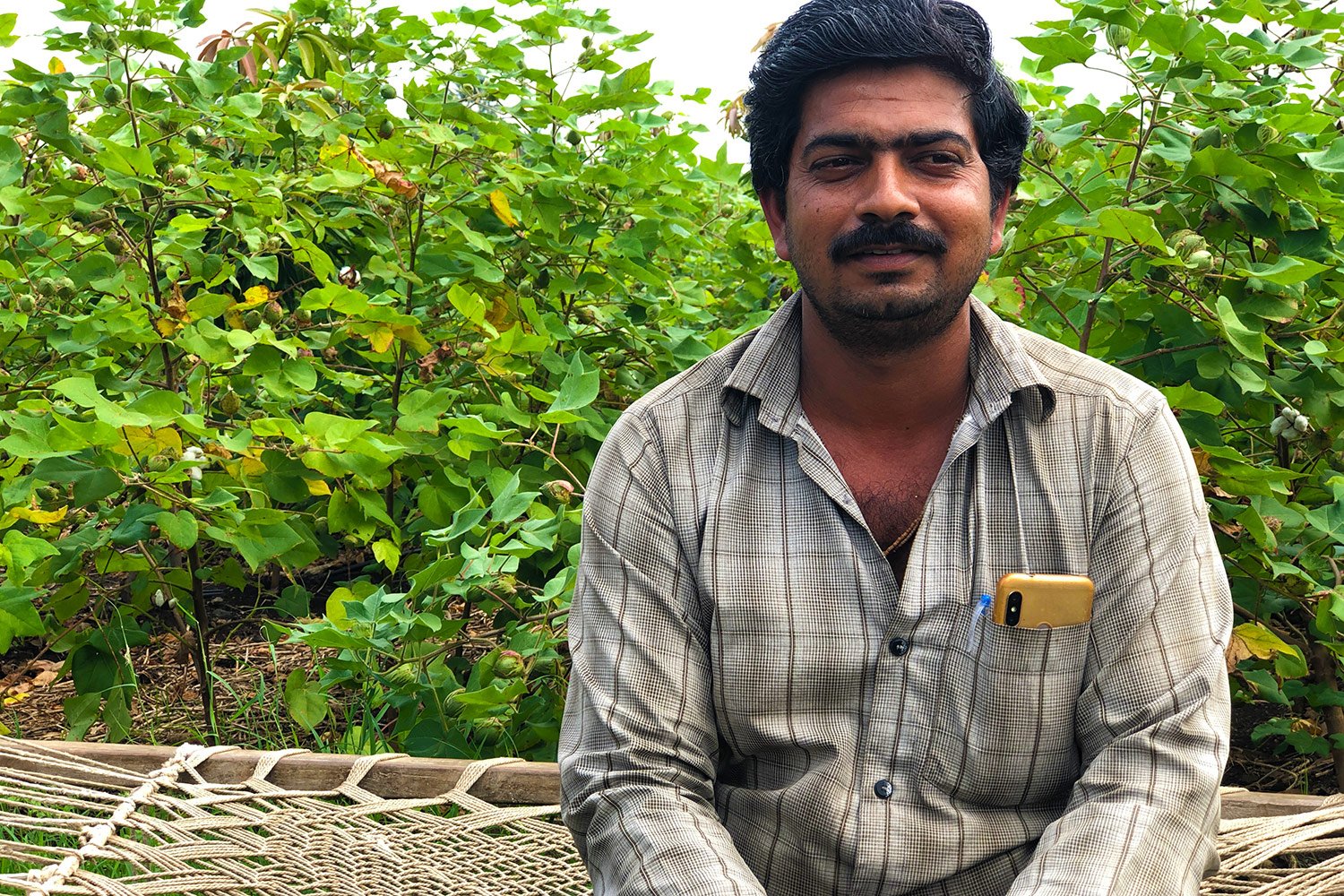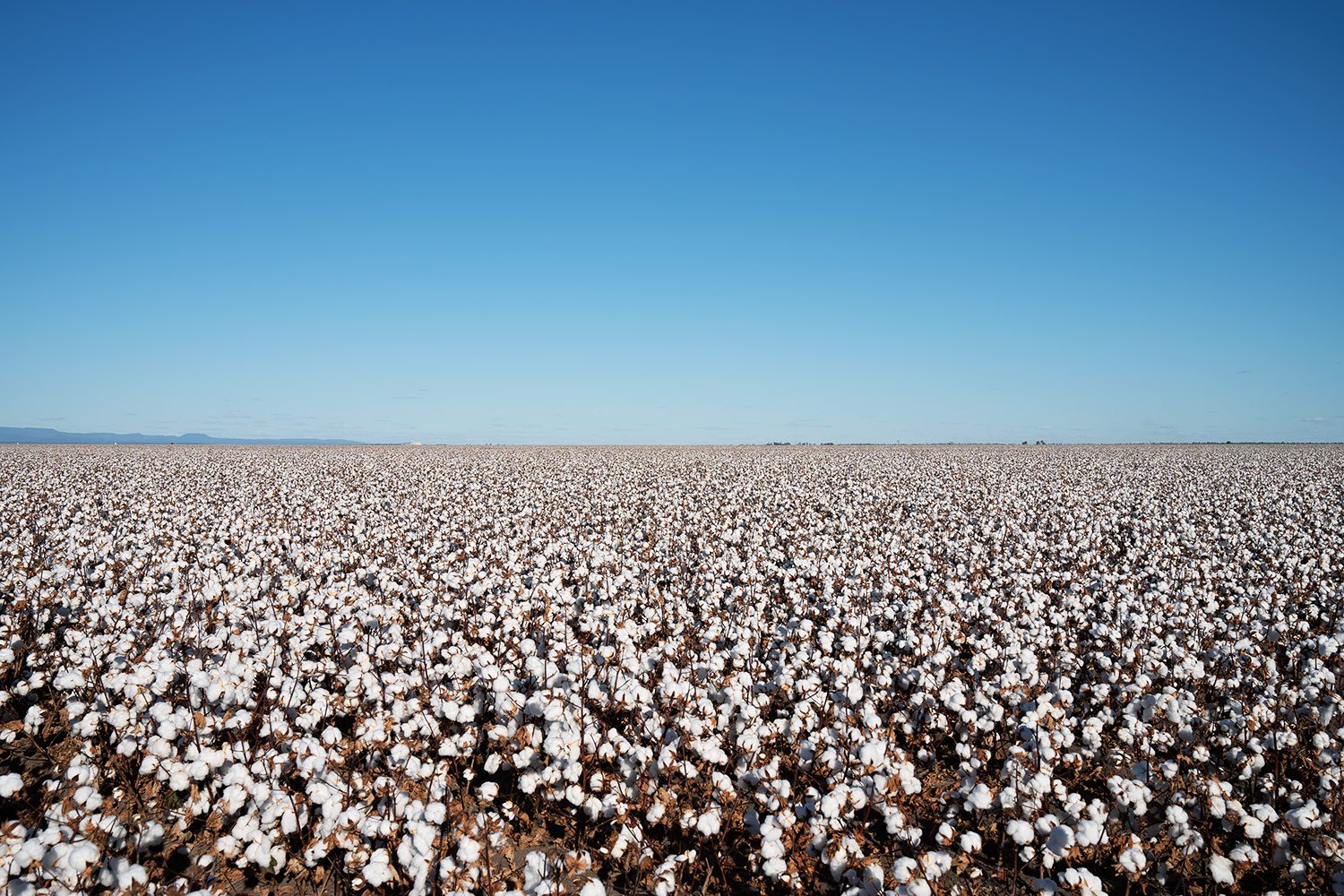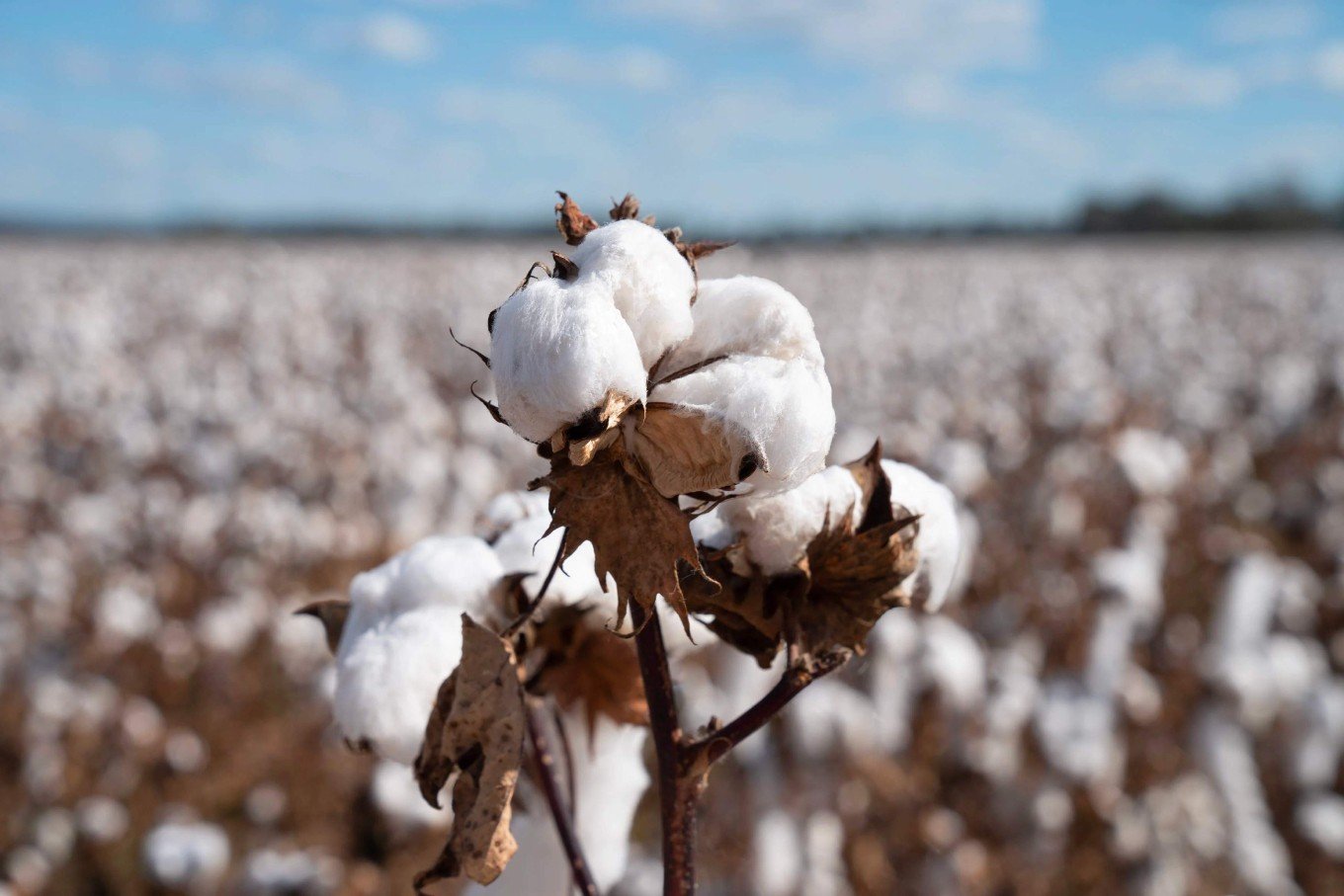Cotton Standards: What's the Difference and Does it Matter?
Sourcing sustainable cotton is an important part of our approach to invest back into our chosen fibre and mitigate social & environmental impacts. For a company of our size with quality being front of mind, committing to a field initiative that caused less disruption to an established supply chain and poses less risk to the availability of quality cotton, made the most sense for us. Better Cotton is produced in greater quantities than organic cotton as it has a more ‘inclusive’ approach alongside other farming methods.
We use a mixture of cotton sourced through BCI, Organic Cotton, Australian Cotton and conventional cotton.
So, what do all these farming standards mean and how do you know if you are supporting sustainable movements?
 Image: Close-up of raw cotton collected and baled from the field.
Image: Close-up of raw cotton collected and baled from the field.
Conventional Cotton
There is debate on what this means, as some believe conventional cotton is any cotton that is not organic. However, the term is widely used for cotton grown outside of any sustainable farming standard. This is what we mean when we refer to conventional cotton, it is the portion of our cotton not yet procured through one of the previously mentioned standards.
Better Cotton
-
Accounts for 20% of the global cotton offering.
-
Grown in 26 countries around the world.
-
There is more BCI cotton available than there is demand for.
-
The increase in Better Cotton is a part of the program. You sign up for a scale-up program with an end goal of 100% Sustainably sourced cotton.
-
BCI’s system is independently evaluated against ISEAL’s Codes of Good Practice–a globally recognised framework for effective, credible sustainability systems.
-
BCI allows for the use of Pesticides & Herbicides however trains farmers on sustainable practices that reduce the use of these.
-
Water stewardship is a part of BCI’s training, teaching farmers water-catching techniques, water recycling, water cleaning, and more sustainable irrigation techniques.
-
Better Cotton has adopted a position of being ‘technology neutral’ with respect to GM cotton and will neither encourage farmers to grow it nor seek to restrict their access to it. Better Cotton Farms produce varying grades of cotton globally. However, often farmers' yield improves in quality and quantity when converting to BCI.
-
Better Cotton program Includes farms that are already operating under alternative sustainable programs myBMP (Australia) CimA (Africa).
-
No forms of modern slavery are accepted on BCI farms.
 Image: BCI Farmer Jagadishbhai Jambuch - member since 2017.
Image: BCI Farmer Jagadishbhai Jambuch - member since 2017.
Organic
-
Accounts for less than 1% of the global cotton offering.
-
There is more demand and claims for Organic cotton than is available.
-
Organic Cotton farming & processing practices are held to strict environmental standards which are audited independently by third-party GOTS-accredited Certification Bodies and form the basis of the GOTS monitoring system.
-
The use of herbicides and pesticides is prohibited.
-
Organic cotton does not require less water to farm but is most commonly grown in rain-fed areas.
-
Organic cotton often yields fewer fibres than GMO cotton, meaning it often requires more plants and more land to produce equal quantities.
-
Organic Cotton does not mean quality cotton is produced. There is still a variation of grades within organic.
-
Organic Cotton is grown in India, China, Turkey, Kyrgyzstan & African countries.
-
No forms of modern slavery are accepted in GOTS certified farms.
Australian Cotton
-
Accounts for 3-5% of global production.
-
No Organic cotton is grown in Australia.
-
Uses Genetically Modified (GM) seeds created by CSD & CSIRO. GM seeds have pesticides + herbicides built in. These seeds are also designed to be nutrient-rich and less reliant on water.
-
Ginning is done locally.
-
Has developed its own farming standard myBMP which covers working conditions, water management, soil health, energy efficiency, minorities development & inclusion, ecology improvement programs + more.
-
Allows for spraying but does not practice prophylactic spraying rather spraying only if there is an issue.
-
Cotton farms are often grown in crop rotations with wheat, corn, etc
-
Australian Cotton produces high-yield and tall staple cotton. Delivering some of the purest cotton to market due to low moisture & oil contamination during picking.
-
Invests back on itself to support the innovative future of farming.
-
43% of the Australian Cotton workforce are women.
-
No forms of modern slavery are accepted on Australian Cotton/ myBMP farms.
 Image: Australian cotton in NSW field pre harvest
Image: Australian cotton in NSW field pre harvest
Myth Busting
Sustainable farming is complicated and not as black and white as it’s often marketed to us.
A lot of the facts you hear about Organic Cotton are unfortunately untrue (like the 91% less water) While there is no doubt that Organic Cotton’s hard rules against herbicides and pesticides are good for the soil, the water and the people. It doesn’t mean that less water or energy is used and it also doesn’t mean that higher quality cotton is yielded from Organic Farms.
Low-grade cotton likely means the garment produced from that cotton has a shorter life due to the quality but high-grade cotton making quality garments with a longer life, is a more sustainable approach.
What is GM Cotton and is it bad?
Genetically Modified seeds mean that resistance to common pests can be built into the seed to remove the need to spray. The development of a new variety can often take 15 years. During this time, agricultural scientists are making sure the cotton grown from the seed modification doesn’t harm friendly insects that are not pests to the plant and the soil in which it’s planted causes no environmental damage or adverse impacts. New cotton varieties that are released, offer improvements in yield, fibre quality, disease resistance and are also designed to be nutrient-rich and less reliant on water. Seed varieties are shared with other countries so that they can see the same benefits and impact reduction.
Realities of Spraying
During a recent farm visit in Australia, we learned that this cotton farmer will spray zero to two times a season, and only if they have to. These farmers work hard towards mitigating issues in alternative ways first, such as the controlled introduction of spiders or other friendly insects that eat the harmful insects and not the plants.
Unfortunately, unforeseen environmental changes such as flooding, can bring new pests or diseases from other regions that the cotton is not resistant to.
In Summary
Better Cotton, Australian Cotton, Fairtrade & Organic Standards + others work in a complementary way toward ensuring that all cotton is produced in a more sustainable and ethical manner. All looking to raise the floor so that worst practices become non-existent.
The cotton industry supports the livelihoods of an estimated 22 million households across 75 countries. When seasonal labour and supporting industries such as ginning are included, estimates are that between 100 million and 150 million people depend on cotton for their cash incomes.
Choosing Organic Cotton products shows brands that people care about sustainability and are willing to pay the extra cost for a smaller footprint. But supporting any brands that are apart of cotton initiatives like Better Cotton or Fairtrade etc are still supporting the betterment of the cotton sector and are enabling support for these communities of those nearly 150 million people globally.
Follow our Cotton Journey
Learn more about our partnership with Better Cotton Initiative, our shared mission, ongoing impact and results so far.
Main Sources:
https://link.springer.com/chapter/10.1007/978-3-319-66981-6_8
https://goodonyou.eco/know-your-product-a-quick-guide-to-organic-cotton/
https://australiancotton.com.au/premium-quality#:~:text=Australia%20is%20the%20leading%20supplier,fibre%20for%20fine%20yarn%20counts
https://www.forbes.com/sites/brookerobertsislam/2021/10/15/organic-water-saving-claims-false-declares-cotton-myth-busting-report/?sh=7d1dc3473013
https://static1.squarespace.com/static/5efdeb17898fb81c1491fb04/t/61de9a24d5a36752adcbf737/1641978418846/CottonPaper_120122_TransformersFoundation_.pdf
https://sustainability.c-and-a.com/uk/en/sustainability-report/2018/sustainable-products/sustainable-materials/more-sustainable-cotton/better-cotton-initiative/
https://global-standard.org/the-standard/gots-key-features
https://global-standard.org/the-standard/gots-key-features/third-party-certification
https://global-standard.org/images/stories/pressreleasehaveyoucottonedonyet_gots.pdf
https://www.mybmp.com.au/
https://bettercotton.org/
https://www.patagonia.com/stories/quality-is-an-environmental-issue/story-93237.html


